- Home
- Stephen E. Ambrose
Supreme Commander Page 10
Supreme Commander Read online
Page 10
For Eisenhower, then, the task was to convince the British that SLEDGEHAMMER could work. He examined various possible landing sites and recommended Le Havre, with a later operation against Cherbourg. He said that the operation should be under British command, with participating U.S. troops attached to appropriate British formations. If the attack went on September 15, the U.S. could contribute two infantry divisions (the 1st and 34th), four tank battalions, and some scattered units.
Estimating the probability of success, Eisenhower warned, was difficult. Landing craft shortages limited the initial landing to one division, aircraft cover would be minimal, and even if the assault force got ashore the Germans might be able to drive it back into the sea. “I personally estimate that, favored by surprise, the chances of a fairly successful landing by the leading division are about 1 in 2,” Eisenhower said, while the chances of establishing a force of six divisions in the area were about 1 in 5.
Following the gloomy prediction, Eisenhower declared and then underscored, “But we should not forget that the prize we seek is to keep 8,000,000 Russians in the war.”
Before a conclusion could be reached, Eisenhower said, two questions had to be answered. Was the Russian situation so desperate as to justify an operation whose costs would reduce readiness for ROUNDUP? And would a partially successful SLEDGEHAMMER help the Russians? Eisenhower felt that if the answer to both questions was yes, then SLEDGEHAMMER was “a practical operation and should be launched at the earliest possible date,” while if the answer to both questions was no, then the Allies should forget SLEDGEHAMMER. If they dropped the 1942 invasion, then the Allies should redouble the BOLERO program. If Russia was defeated that fall the Western Allies should “go immediately on the strategic defensive in the Atlantic” and prepare to assume the offensive against Japan.19
On Saturday, July 18, and the following morning, Marshall, Eisenhower, King, Clark, Admiral Harold Stark, the commander of the U.S. naval forces in the British Isles, and various staff officers from Washington and London talked over Eisenhower’s recommendation. Marshall adopted them with only one important change: the site of the attack should be Cherbourg, not Le Havre. The Chief of Staff then asked Eisenhower to prepare a formal memorandum that he could present to the BCOS the next day.
Eisenhower had a memorandum ready that night. Much of his paper repeated what he had already said in the notes he had handed Marshall. He did attempt to make the British see what was at stake by declaring that, if the Western Allies allowed the Germans to “eliminate an Allied army of 8,000,000 men, when some stroke of ours might have saved the situation,” then they “would be guilty of one of the grossest military blunders of all history.” He therefore recommended that preparations for SLEDGEHAMMER go forward and that in early September an evaluation of the Russian situation be made. At that time a final decision on SLEDGEHAMMER could be reached. This proposal had the great advantage of stalling Churchill while holding out to Roosevelt the promise of some action in 1942. If in September the decision was not to go on with SLEDGEHAMMER, it would be too late to mount a North African expedition.20
On Sunday night, July 19, Marshall, King, Eisenhower, and Clark worked on the memorandum. The final version, which Marshall presented to the BCOS and Churchill on Monday morning, was much shorter than the one Eisenhower had written. Marshall dropped most of the strategic arguments and simply concentrated on proposing that an attack be made on Cherbourg. He argued that the assault force, once ashore, could remain and would draw Germans from the Russian front.21
All day Monday and again on Tuesday the British argued with Marshall. Eisenhower noted that “the decisions to be made are not only highly secret but momentous. There is an atmosphere of tension that will disappear once the decisions are completed and we actually know what we are to do.”22* Marshall held out for SLEDGEHAMMER, carefully and fully answering all British objections. Eisenhower and Clark stayed up until after midnight each night providing their Chief with information on American landing craft production, delivery schedules, intelligence estimates of German strength, and so on. But time and again the British rejected Marshall’s arguments and made it clear that they were absolutely against the attack. As Eisenhower summed it up, the British believed SLEDGEHAMMER “would have no beneficial effect on the Russian situation” and in addition felt “the chances of tactical disaster are very great.”
The American officers, Eisenhower noted, “sat up nights … and have tried to open our eyes clearly to see all the difficulties and not to be blinded by a mere passion for doing something.” The last factor, he added, could not be ignored, for the British and American people “need to have the feeling that they are attempting something positive.” An added irritation to the Americans was their feeling that only Churchill, not the British professional soldiers, stood in their way. “I have held earnestly to the opinion that any fight this year should be within the general scope of the ROUNDUP objectives, and designed to forward and facilitate ROUNDUP when it can occur,” Eisenhower reported to a friend in the War Department. “In spite of the fact that a great many of the British Air and Army officers agree to this view in private, the government itself was dead against it.”23
On Wednesday, July 22, the climax came. Eisenhower sat in his office and chatted with an aide, admitting that it had been a tough grind and that he was worried about his recommendation to mount SLEDGEHAMMER. If it was adopted, he said, “I sincerely hope that it works out with reasonable success.”24 Marshall and King met with Churchill and the BCOS. After a heated debate, the Americans “admitted defeat” and abandoned SLEDGEHAMMER. The British were unalterably opposed, and that was that.25
Marshall cabled Roosevelt to admit that he and the British were deadlocked. Roosevelt sent back orders for Marshall to develop plans to bring American ground troops into action against the Germans in 1942. He said Marshall could choose from an offensive against French North Africa in combination with the British, or one carried out by Americans alone, or JUPITER, or sending American troops into Egypt to fight under the British Eighth Army, or an operation through Iran into the Caucasus.26
Before deciding, Marshall turned to Eisenhower, asking him to prepare yet another paper. By this time Eisenhower may have wondered what was the point of his leaving OPD. He was, in addition, depressed. At breakfast on Thursday morning, July 23, he and Clark talked about the end of SLEDGEHAMMER. “Well, I hardly know where to start the day,” Eisenhower said. “I’m right back to December fifteenth.” He thought that Wednesday, July 22, 1942, could well go down as the “blackest day in history.” Despite his mood he gathered together his staff and “they settled down to assemble pieces of the wreckage of their plans.”27 By evening Eisenhower had an eleven-page “Survey of Strategic Situation” ready for Marshall.
It began with a list of assumptions—no cross-Channel attack in 1942, no offensive in the Pacific, and so on. After a long review of the German, British, and American military situations, Eisenhower considered three possible operations: reinforcement of the Middle East, an attack in northwestern Africa (GYMNAST), or the seizure of the Azores and the Cape Verdes. He listed the advantages inherent in a reinforcement of the Middle East but pointed out that the operation “is purely negative in purpose” and involved much costly shipping. The idea of operating against Atlantic islands was also negative and defensive, so was not worth serious consideration.
This brought Eisenhower to GYMNAST, another defensive operation “designed to limit German exploitation in Africa” and to relieve the situation in the Mediterranean. If successful, it could deny North Africa to the Axis, protect sea communications in the South Atlantic, provide air bases, ease the shipping crisis by opening the Mediterranean, and provide direct support to the Middle East. The disadvantages were obvious, especially the most important one—if Marshal Henri Pétain ordered Vichy’s troops to resist, he could delay or jeopardize the operation and Vichy would become actively allied with the Germans. GYMNAST would pull American naval forces from the
Pacific, open a new theater, and possibly bring Spain into the war on the German side. Most of all, like the option of reinforcing the Middle East, mounting GYMNAST would mean postponing ROUNDUP.
In the end, therefore, the only major operation Eisenhower liked was ROUNDUP. What he and Marshall really wanted was to get by in 1942 doing as little as possible. One way to do that and still satisfy the President might be to send what would amount to a token force to the Eighth Army, which would alleviate the “On to Richmond” type of pressure while causing minimum interference with ROUNDUP. Eisenhower’s final recommendations, therefore, were to make no cutback on BOLERO, to send one U.S. armored division to Egypt, and to undertake no major operation which would interfere with ROUNDUP.28
The proposal to send a token force to Egypt and to delay making any other decisions might have satisfied the President, who had listed such action as one of the alternatives available to Marshall. In addition, on July 15, Marshall had had his planners in OPD prepare a study on the same subject, and they had reached the same conclusion as Eisenhower. Given the vehemence with which Marshall had attacked GYMNAST, it would have been consistent for him to agree.
But Marshall rejected the recommendation. His experiences with Pershing in World War I, when the British and French had tried to gobble up the American Army piecemeal, may have made him leery of sending American divisions into British armies. He may have been suspicious of Eighth Army leadership—certainly the British record in the desert would not have filled him with confidence in British methods or made him anxious to place his soldiers under British command. He may also have doubted that he could get away with sending just one division to Egypt, as Eisenhower had hoped, since the President wanted to get at least five American divisions into action before Christmas. Still, the proposal to reinforce the Eighth Army in the desert represented a most intriguing alternative to the over-all strategy of World War II. The British quite possibly would have been satisfied with one armored and one infantry division, which would have made ROUNDUP feasible. The Eighth Army alone, in the end, proved strong enough to drive the Germans across Africa. Opening a new theater in North Africa not only required more shipping, it dictated the strategy of 1943 in a way that reinforcing the Eighth Army would never have done. Marshall’s decision to ignore the recommendation was a crucial one; surprisingly, it is ignored by almost all historians, including Marshall’s official biographer. Perhaps the reason for the neglect is that Eisenhower and Handy, awed as always by Marshall, did not push. As soon as the Chief announced his decision, they accepted it, abandoning their own brain child.
On July 24 Marshall and King met with the British. Marshall proposed to invade North Africa that fall, although he wanted the final decision delayed until September 15, when a study of the Russian situation would be made. The British agreed, and when Marshall left London shortly thereafter he thought nothing would be done before September 15.29
Churchill thought otherwise and so, it turned out, did the President. Both men ignored the contention that GYMNAST meant the end of ROUNDUP, both professed their eagerness to go ahead with a 1943 cross-Channel attack, both paid no attention to the September 15 decision date, and both were delighted to have a firm agreement. They exchanged joyful telegrams and before Marshall even got back to Washington it was all settled. Operation TORCH, as it was rechristened, would be the first Anglo-American offensive since the French and Indian War.
July 22, 1942, was hardly history’s blackest day, but of course Eisenhower had said it might have been, not that it was. There are two unanswerable questions with regard to the decision for TORCH. First, was the gamble of leaving the Russians to their own devices justifiable? Since Russia did win, it would seem so. In the West, however, not enough is known of the true Russian situation that summer. It seems fair to say that the Red Army was in dire straits, and certainly many German generals later felt that had Hitler adopted a more orthodox plan the Germans could have forced a general Soviet collapse.
Marshall was quite right in arguing that TORCH made ROUNDUP impossible, so the second question is, did TORCH delay the final victory? This is even more speculative than the first, for it really asks, could ROUNDUP have worked? German coastal defenses in 1943 were not as strong as they were in 1944, but then Allied air power in 1943 was not what it would become in 1944. Most of the Allied air effort in 1943, however, had gone into the Mediterranean—it could have been used against Germany. The Nazis did not reach total mobilization until 1944, but neither did the Americans. U.S. troops were neither fully trained, equipped, nor blooded in 1943. The Allies did not have the landing craft in 1943 that they would have in 1944. The German eastern front in 1943 was farther into Russia than it would be a year later, so the Wehrmacht would have found it more difficult to transfer troops from one front to the other.
The argument can go on and on and on; each advantage for either side in 1943 is balanced by a disadvantage. Looked at from another point of view, the question is, what contribution did TORCH make to the final victory? Since Erwin Rommel’s Afrika Korps was to be defeated at El Alamein before the Allies launched TORCH, the major accomplishments of TORCH and later Mediterranean operations were to (1) free shipping and (2) drive Italy out of the war. But TORCH took up as much shipping as it freed, and the Germans—paying a high cost—occupied Italy before it left the war. TORCH did give the British a better political position in the Mediterranean immediately after the war, but in the long run that was not worth much.
One advantage of TORCH often overlooked is that it gave the American Army battle experience and provided Marshall and Eisenhower with a better idea as to which generals were going to be successful as combat commanders. A number of the ground force commanders for TORCH proved wanting and had to be sent home; by the time of OVERLORD the American team was settled and Eisenhower had few disappointments with his subordinates. Had the cross-Channel attack gone in 1943, the Americans would have hit the beaches with raw troops fighting under untested leaders, which would have been costly and could have been disastrous. Finally, TORCH did give the Americans a 1942 offensive against the Germans, which presumably helped morale in the U.S.
There can be no authoritative answer to the question, did TORCH delay the end of the war? One thing does seem clear: the only chance the British and Americans had of winning the war sooner was to mount the cross-Channel attack earlier. The risks would have been greater, but so would the rewards. If successful, ROUNDUP might have led to a link-up of Western troops with the Red Army somewhere near the old Polish-Russian frontier sometime in 1944. The implications of a Western liberation of central Europe are enough to justify Butcher’s comment on July 16: “Upon the discussions to take place in the next few days may rest the future history of the world.”30
The speculation can and will go on forever. For Eisenhower, in the summer of 1942, the point was that everything he had worked on for the preceding six months was in the ashcan, and it was time to start all over.
* As Eisenhower told his brother on July 24, “We are living under conditions of considerable strain and pressure. It has been particularly bad for the past week and shows no promise of letting up for another week.” To Edgar Eisenhower, EP, No. 391.
CHAPTER 6
The Transatlantic Essay Contest
The atmosphere at 20 Grosvenor during the week of Marshall’s visit had been tense; over the next three weeks it became confusing. Organization, plans, even basic decisions were up in the air. The confusion resulted from the CCS statement that no decision should be made until September 15 and Marshall’s refusal to accept the President’s rejection of that statement. At the July 25 meeting of the CCS the Chiefs had faced the problem of appointing a commander for TORCH, for although they felt that the operation was still tentative it was necessary to get on with the planning. The British wanted an American to take the position of Supreme Commander, but Marshall was hesitant to move without consultation with the President. At this point Admiral King remarked, “Well, you’ve got h
im right here. Why not put it under Eisenhower?”1 The British agreed, their idea being that Eisenhower would be in charge of planning until Marshall or someone else could take over.
Marshall then remarked that he wished to avoid competition for resources between ROUNDUP and TORCH and Brooke suggested that initially the Supreme Commander should be responsible for both so that he could shift resources from one to the other in line with later decisions. The Americans accepted the proposal and the meeting broke up. Marshall then went back to his suite at Claridge’s and asked Eisenhower to come to his room. When Eisenhower arrived Marshall was in the washroom. Through the closed door he called out that Eisenhower was now in charge of planning for TORCH and that he and King favored him for command of the expedition.2
By August 2 Marshall was back in Washington and the somewhat confused arrangements began to become clearer. The BCOS, uncertain as to Eisenhower’s role, had wired their Joint Staff Mission in Washington for clarification; the reply indicated that Eisenhower was to assume “immediate executive authority” for TORCH planning.3 The same day Eisenhower met with the BCOS, who said they objected to the title “Supreme Commander” and suggested in its place “Commander in Chief.” Eisenhower had no objection. He also agreed with a British recommendation that an American become his deputy so that the American character of the expedition would be maintained even if the original commander were disabled. In effect, this meant Eisenhower now commanded TORCH.
The British also said they wanted to increase the size of the total force from seven to twelve divisions, which meant that TORCH’s objectives and importance were increased. Marshall and King had proposed the old GYMNAST to the British, but TORCH had now become an expedition designed to go far beyond the occupation of French North Africa. Its new aim was to drive the Axis from Africa altogether. This increase in scope made Eisenhower’s responsibilities far too broad for one man to handle. He was Commanding General, ETO, in charge of planning for BOLERO-ROUNDUP and TORCH, had to furnish an American detachment for a combined planning team, control the team once it was established, and in accordance with the July 25 decision of the CCS present as soon as possible an outline plan for TORCH. His first move to clear his desk was to assign Major General Russell P. Hartle as deputy theater commander, ETO, and turn most ETO problems over to him. He then appointed Clark deputy Allied commander in chief for TORCH and put him in direct charge of all TORCH planning.4

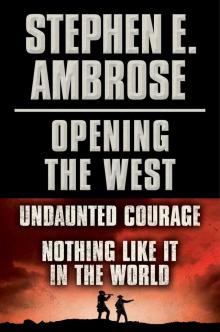 Undaunted Courage
Undaunted Courage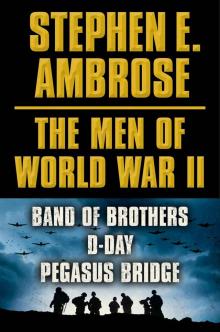 The Victors: Eisenhower and His Boys
The Victors: Eisenhower and His Boys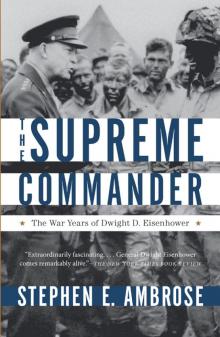 The Supreme Commander
The Supreme Commander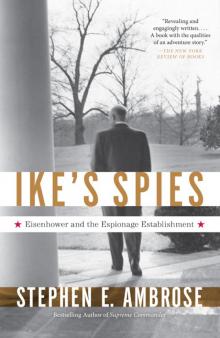 Ike's Spies: Eisenhower and the Espionage Establishment
Ike's Spies: Eisenhower and the Espionage Establishment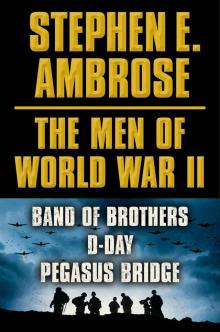 The Men of World War II
The Men of World War II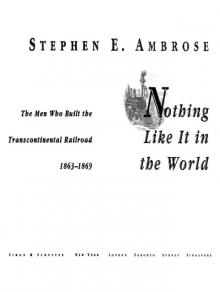 Nothing Like It in the World The Men Who Built the Transcontinental Railroad 1863-1869
Nothing Like It in the World The Men Who Built the Transcontinental Railroad 1863-1869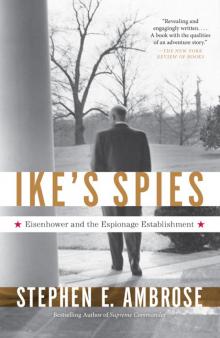 Ike's Spies
Ike's Spies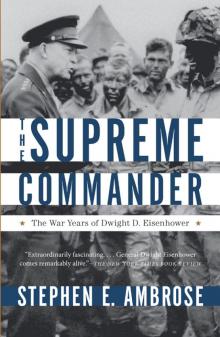 Supreme Commander
Supreme Commander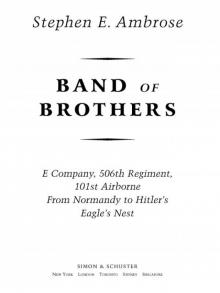 Band of Brothers
Band of Brothers